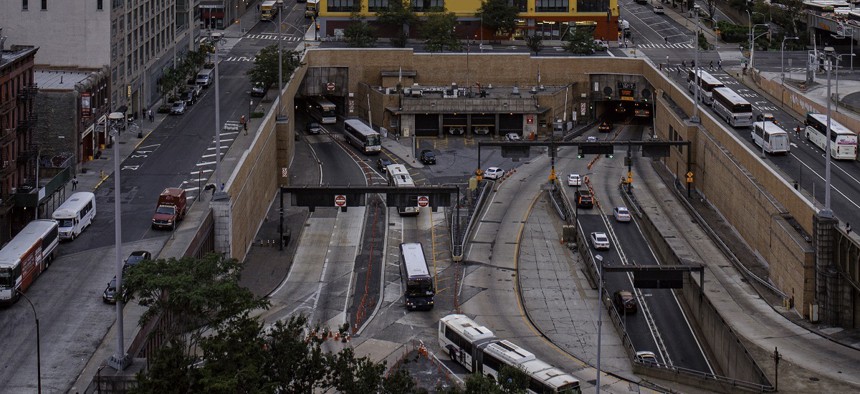New York City
Congestion pricing sensors excluded from Lincoln Tunnel property, draws outcry from electeds
Officials representing Manhattan’s Hell’s Kitchen alleged gantries used for the upcoming toll program were deliberately kept off land owned by the Port Authority of New York & New Jersey.

No congestion pricing sensor have been installed on the land around the exit tubes of the Lincoln Tunnel (Image by ©fitopardo)
The Port Authority of New York and New Jersey is refusing to install congestion pricing technology on the agency’s properties, according to elected officials representing Manhattan’s Hell’s Kitchen neighborhood.
The agency was accused of purposely not installing gantries, which work like EZ Pass sensors to automatically impose a toll on motorists who travel below 60th Street into Manhattan’s central business district, on its property around the Lincoln Tunnel. The tunnel’s tubes exit onto Manhattan streets within the district.
Instead, 40 sensors were placed in Hell’s Kitchen, which is just outside the tunnel on Manhattan’s west side, the electeds charged in an Oct. 6 letter sent to Gov. Kathy Hochul, New Jersey Gov. Phil Murphy, Metropolitan Transportation Authority CEO Janno Lieber and the Port Authority’s executive director, Rick Cotton.
New Jersey’s refusal to cooperate with New York state transit officials has turned a good idea into an eyesore, said state Sen. Brad Hoylman-Sigal, Rep. Jerry Nadler, Assembly Members Linda Rosenthal and Tony Simone, Manhattan Borough President Mark Levine and City Council Member Erik Bottcher in the letter. The electeds support the upcoming toll program, but were frustrated by how much Hell’s Kitchen was being impacted with the gantries roll out.
The lawmakers specifically asked that the gantries be placed on Lincoln Tunnel property to conserve sidewalk space and free up side streets. The letter also said the affected streets in Hell’s Kitchen have “the feeling of a highway” after the gantries’ installation and asked for greater cooperation between the Port Authority and MTA.
Nadler said in a statement to City & State that the Port Authority’s placement of the gantries plays right into New Jersey’s ongoing litigation against New York state over congestion pricing.
“The Port Authority’s refusal to work with the MTA to integrate gantries within the Lincoln Tunnel’s existing infrastructure results from New Jersey’s ill-conceived opposition to congestion pricing,” he said, “which will ultimately benefit the hundreds of thousands of transit commuters from New Jersey who rely on NYC subways daily.”
New Jersey launched a lawsuit in July against the federal government over its approval of the congestion pricing program. Murphy said previously that the toll system would harm New Jersey residents and that his state was not properly involved in the planning process.
Hoylman-Sigal bluntly accused the Port Authority of being under direct orders from New Jersey officials not to install congestion pricing infrastructure on Port Authority property.
“They can’t cross New Jersey and are in effect doing their bidding,” he said. The state senator added residents and business owners have complained as the neighborhood has been transformed into a “giant parking lot.”
“We’ve been trying to make this neighborhood liveable for years,” he said, adding Port Authority officials don’t want to get in the middle of the dispute.
The issue is compounded by the fact the “MTA can’t force the Port Authority’s hand,” Hoylman-Sigal said, the only solution being action from Hochul.
“New Jersey’s eating our lunch and New York as far as I can tell is taking the punches,” he said.
Representatives for the MTA and the Port Authority referred City & State to the Hochul administration, which explained that the gantries were being placed on land controlled by the New York City Department of Transportation. “This equipment is being built on land owned by NYC DOT, one of the partners on this project, and installation remains on schedule to meet the expectation that tolling will begin next year,” a spokesperson said in an email to City & State.
Representatives from Murphy’s office did not immediately respond to a request for comment.
With reporting by Ralph R. Ortega.

NEXT STORY: Poll: Majority of New Yorkers support aid to Israel

